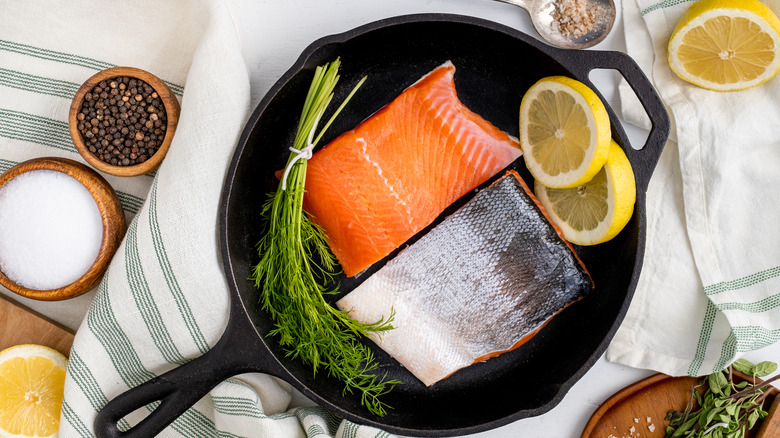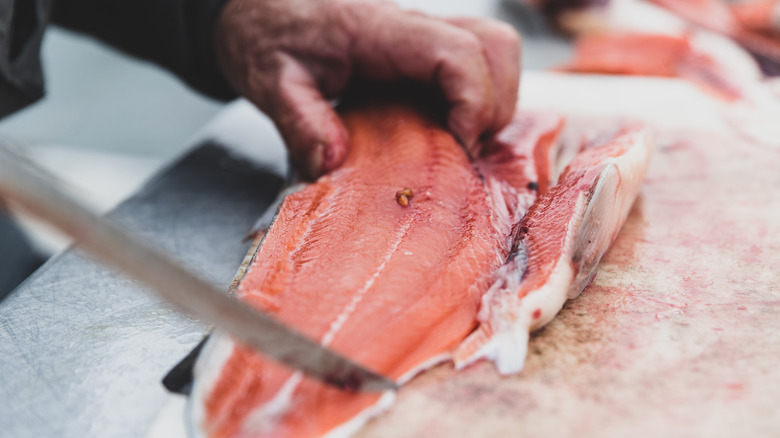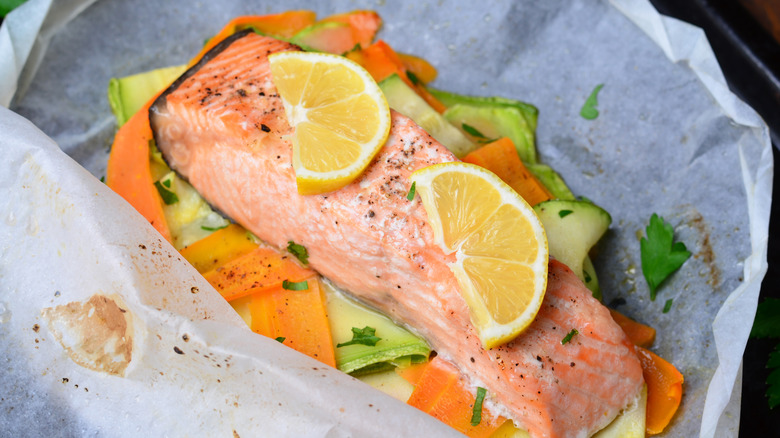The Mild Variety Of Salmon Even Fish-Haters Should Try
When talking about the healthiest foods, salmon is almost bound to get a mention. The fish is the perfect nutritional package: high in protein, relatively low in calories, an excellent source of omega-3 fatty acids, and loaded with B vitamins. It's also easy to prepare. You can grill it, smoke it, bake it in a Ritz Cracker coating, slice it raw, or eat it right out of the can. Given its versatility and health benefits, salmon is pretty popular — so popular in fact that it is the second most consumed seafood per capita in the United States, according to data from the National Fisheries Institute.
But despite all these qualities, there's still a large swath of people turned off by salmon's distinct flavor. And while it's true that certain varieties can have a faint down-by-docks taste and odor, this is certainly not true for every species of salmon you encounter. But what if you could capture all of salmon's advantages without that fishy taste? Well, then you've got to try coho salmon. This species of salmon has a softer, sweeter flavor than other varieties like king, sockeye, or Atlantic. It is particularly delicious when poached or lightly sautéed, and has a smooth, buttery texture.
Why coho salmon is so special
Coho, also known as silver salmon, is one of six different species found in the Pacific Ocean. The fish has an intensely glittery silver skin (hence the nickname) and bright, blood-orange flesh that's quite striking when presented on a bed of ice at the seafood counter. The fishing season for coho is quite short, running only from July to October, which makes this variety of salmon exclusive and desirable. And while it is available in limited supply, wild-caught coho is not at risk of overfishing; it's actually categorized as a sustainable seafood by the National Oceanic Atmospheric Administration (NOAA), thanks to the strict harvesting protections and responsible fishery management.
Due to its lower fat content, coho is sweeter and subtler in taste than other types of salmon, making it a terrific option for people sensitive to fishiness. Its flavor, which is described as both "earthy" and "nutty," is complex, exciting, and more nuanced than the farm-raised varieties more commonly available in supermarkets. As far as texture is concerned, because it is a leaner species of salmon, coho can be on the firmer side, albeit still soft and flaky when properly prepared.
How to cook coho salmon like the pros
Coho salmon doesn't require a lot of finesse or fancy techniques — you just don't want to overcook it. One way to preserve its moisture is to poach it in a light, aromatic cooking liquid of white wine, lemon juice, shallot, garlic, and dill. Another style is to cook it en papillote, or in parchment. For this approach, the salmon filets are added to a pouch of parchment paper, along with some slices of lemon, fennel, shallot, and fresh herbs, and baked in the oven, effectively steaming the fish and preserving its delicate texture.
And despite it being on the leaner side, you can still cook your coho in the frying pan. The keys here are patting the filet dry with a paper towel and using a pre-heated pan so that the fish can develop a handsome crust without drying out. Just add a drizzle of oil to the pan and cook the salmon for three to four minutes on each side. But if you're feeling really ambitious (and have a few hours to spare), you can impress your friends with a beautiful maple-cured smoked salmon. But let's say you don't want to cook at all — in that case, then you can always prepare your fresh coho sashimi style. Yes, the fish is so delicate in flavor that even salmon haters will enjoy it — raw or cooked.


